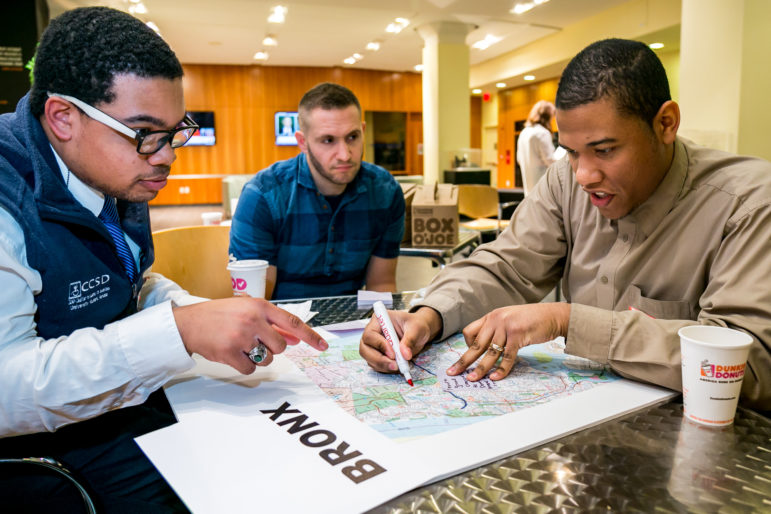
Adi Talwar
Marking the map of potential infrastructure improvements in the Bronx.
New train lines connecting Queens to Central Brooklyn and the West to the East Bronx …
Renovations to public housing, along with playgrounds and bike lanes for neighborhoods throughout the outer boroughs …
Highways converted to tunnels with overhead green space for Bronxites to play and picnic …
These are a few of the wish list items offered by attendees at The Punch List: Infrastructure and Inclusion in the Trump Era, a City Limits’ event held Wednesday night and focused on President-elect Trump’s promises to rebuild America’s infrastructure. Certainly New York could use some rebuilding, but will ordinary New Yorkers really stand to benefit from a Trump infrastructure plan?
(Video, photos and audience input from the event is below.)
Our panel of experts gave us the (literal) lay of the land. Veronica Vanterpool, executive director of the Tri-State Transportation Campaign, explained that the United States invests far less in infrastructure than other developed nations, spending less than 2 percent of GDP on infrastructure as opposed to the 10 to 15 percent of GDP dedicated by other rich nations. The funds we do spend are spread unevenly, with highway infrastructure often supported at the expense of public transit, pedestrian safety and bicycling roads—and the glitzy projects favored by politicians taking priority above less sexy ones, as journalist Neil deMause pointed out.
Many Democrats are treating Trump’s infrastructure ambitions as his saving grace—including Governor Cuomo, who has expressed an interest in working with the new administration and just launched his own $100 billion infrastructure plan to improve the state’s roads, bridges, subways, airports, railways, broadband, and other physical capital. Transit unions would also stand to benefit from an infrastructure plan: As Amalgamated Transit Unionist Ed Watt noted, public transit projects produce more jobs than road construction, with every $1 billion in transit creating 41,000 jobs.
But as Watt and deMause explained, little is known about what and how Trump plans to rebuild America—especially when Republicans in Congress have been deeply inimical to increased government spending. A white paper released by Trump’s campaign team in the fall suggested the administration would instead give tax credits to private enterprises to build new infrastructure projects.
According to panelists, a tax-credit model would limit the kind of infrastructure that could be built. Private enterprises seek a profit, and can’t finance their entire projects using tax credits, so they would typically pursue projects that incorporate a revenue-generating mechanism, such as a highway with a toll system. It will be challenging to find ways to use tax credits to fund less-than-lucrative projects, such as the creation of bike lines, or rural roads where few people live.
“As soon as you start getting into this issue of how do you leverage private money, then what’s driving the decisions about what these [infrastructure] priorities…are the priorities of private interests,” deMause said.
Of course, defining what should be New York’s infrastructure priorities—a Second Avenue subway or public housing, an airport renovation or a new Port Authority Terminal—is itself hotly controversial. For starters, we can begin by having more community conversations, like the one held with event attendees Wednesday night, where attendees took pens to maps of the five boroughs to identify their own infrastructure priorities.
Video by Marc Bussanich
“It often takes longer to travel from one point in the Bronx to another than it takes to travel from the Bronx to Midtown Manhattan,” said Nelson Beltran, a Bronx resident, in a call for an extension of the D train up to Co-Op City, more express trains in the Bronx, and more accessible train stations, while Richard Brause said Staten Island’s abandoned North Shore rail line is a “wonderful capital resource” that could be developed into a Bus Rapid Transit system or light railway without the expense of acquiring more land.
In any case, if Trump is about to drive the private sector to rebuild some stuff, what will those projects be like? Important questions are yet to be answered about the labor conditions and wage standards that would be used in such projects. According to the AFL-CIO, Trump has a sketchy record when it comes to labor, often turning to non-union labor when he had a choice. In addition, Vanterpool, noting that most public transit systems operate in the red and are not highly lucrative, wonders what revenue-generating schemes might be adopted so that companies can meet their bottom lines.
“If we turn them into private hands, what does that mean for profitability, affordability?” she asked.
On the flip side, if New Yorkers decide Trump is not going to deliver the infrastructure plan they want, the question will then become: where do we get the capital to make the investment we so direly need?
All photos by Adi Talwar

Adi Talwar
Veronica Vanterpool of the Tri State Transportation Campaign speaks as Amalgamated Transit Union official Ed Watt, City Limits' Murphy and author Neil deMause look on.

Adi Talwar
Plenty of ideas for improving Queens, from parks to public housing, from bike lanes to sea barriers.

Adi Talwar
Big ideas for the Bronx: Doing more with the Grand Concourse and Gun Hill Road, and thinking more about what disabled riders need.

Adi Talwar
Proposals for infrastructure in Brooklyn: Atlantic Avenue as a complete street, new bus rapid transit along north-south routes.
What Our Guests Want to See New York Build Next
| Borough | Project |
| Brooklyn | Widen and separate pedestrian and bike paths across the Brooklyn Bridge |
| Bus Rapid Transit line (or new subway) connecting central and north Brooklyn with Queens | |
| Reduce LIRR fare for city residents | |
| Turn Atlantic Avenue into a ‘complete street’ with bike lanes and bus rapid transit as well as private vehicles | |
| Manhattan | Complete second phase of the 2nd Avenue Subway |
| Congestion pricing — but call it something else! | |
| Complete suspended construction of 7 train station at 42nd and 10th | |
| Extend 7 train down to 23rd Street | |
| Improve signals on the Lexington Avenue line | |
| BRT with full protected lanes and signal preference on 125th Street | |
| BRT with full protected lanes and signal preference on 34th Street | |
| Staten Island | Utilize rail right-of-way along north shore as a transit corridor |
| Bronx | Turn Grand Concourse into a complete street with bike lanes, plazas and beautification |
| Make more subway entrances accessible | |
| Improve east-west transit by, among other things, extending the D train along Gun Hill Road | |
| Queens | More parks in northwest Queens |
| Improve poorly designed bike lanes in LIC (and enforcement) | |
| Improve subway connections between Brooklyn and Queens | |
| Clean up Newtown Creek | |
| Restoration of the NY State Pavillion in Flushing Meadows | |
| Restoration of old LIRR line | |
| Restoration of Jamaica Bay | |
| Build sea wall to protect southern Brooklyn and Queens | |
| Remove toll brides to the Rockaways | |
| Citywide | Renovation of NYCHA properties |
| Upgrading parks and playgrounds to make them accessible to the disabled |
City Limits will be reporting on infrastructure issues over the next year. If there’s an infrastructure project you think New York City needs, let us know: Comment below, email them to us at editor@citylimits.org or tweet them out (@citylimitsnews is our handle and #infrastructureNYC is the hashtag).







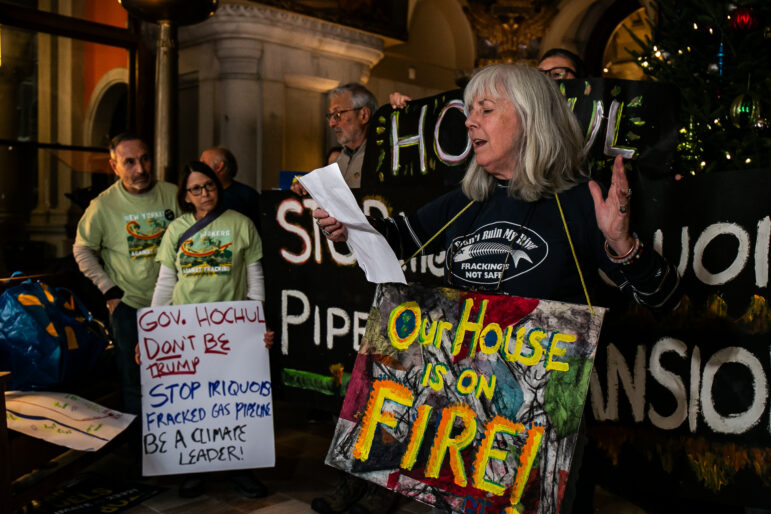
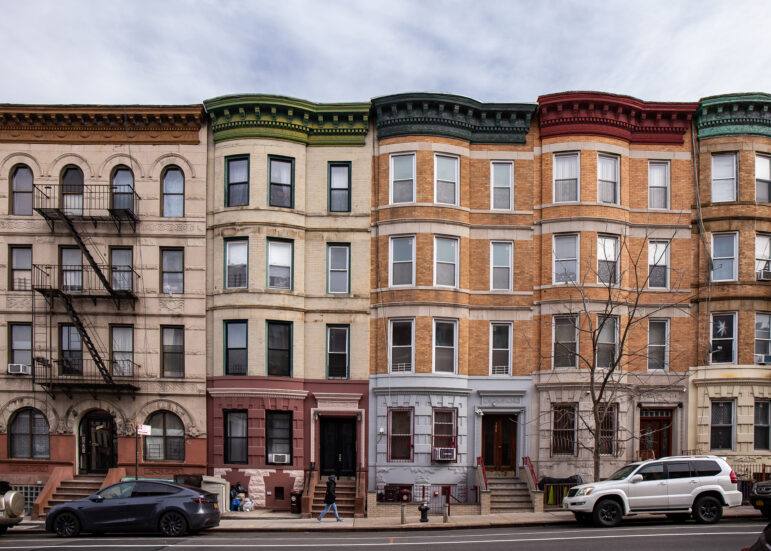
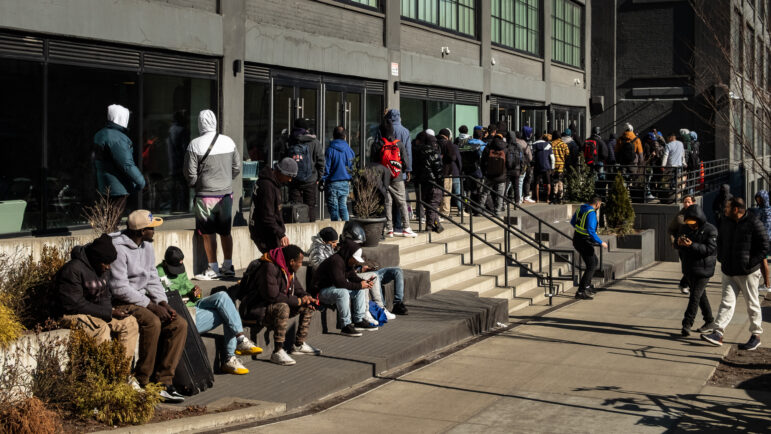
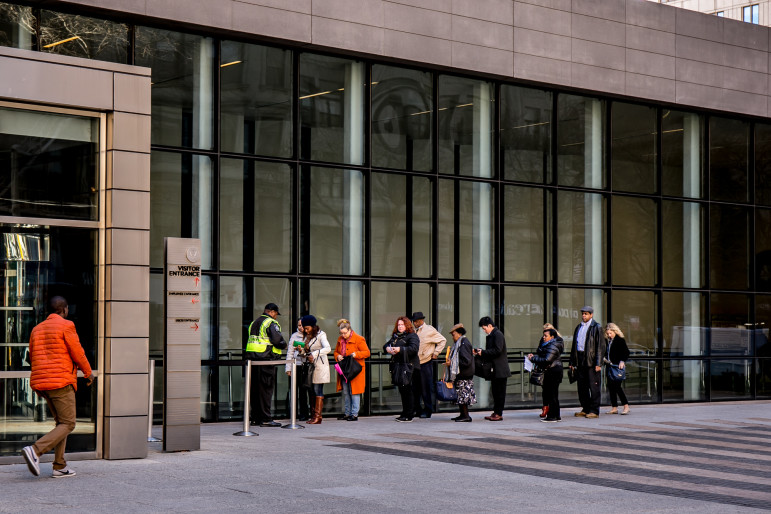


One thought on “Video: Will Trump’s Infrastructure Plan Help NYC?”
Peace and Blessings, I found the video above to be very informative. Please add me to your listing.
Thank you,
Harold Fogle Jr